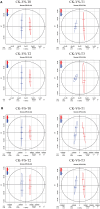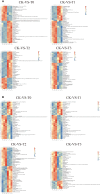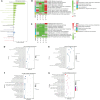Metabolomics and physio-chemical analyses of mulberry plants leaves response to manganese deficiency and toxicity reveal key metabolites and their pathways in manganese tolerance
- PMID: 38911982
- PMCID: PMC11192020
- DOI: 10.3389/fpls.2024.1349456
Metabolomics and physio-chemical analyses of mulberry plants leaves response to manganese deficiency and toxicity reveal key metabolites and their pathways in manganese tolerance
Abstract
Introduction: Manganese (Mn) plays a pivotal role in plant growth and development. Aside aiding in plant growth and development, Mn as heavy metal (HM) can be toxic in soil when applied in excess. Morus alba is an economically significant plant, capable of adapting to a range of environmental conditions and possessing the potential for phytoremediation of contaminated soil by HMs. The mechanism by which M. alba tolerates Mn stresses remains obscure.
Methods: In this study, Mn concentrations comprising sufficiency (0.15 mM), higher regimes (1.5 mM and 3 mM), and deficiency (0 mM and 0.03 mM), were applied to M. alba in pot treatment for 21 days to understand M. alba Mn tolerance. Mn stress effects on the net photosynthetic rate (Pn), stomatal conductance (Gs), transpiration rate (Tr), intercellular CO2 concentration (Ci), chlorophyll content, plant morphological traits, enzymatic and non-enzymatic parameters were analyzed as well as metabolome signatures via non-targeted LC-MS technique.
Results: Mn deficiency and toxicity decrease plant biomass, Pn, Ci, Gs, Tr, and chlorophyll content. Mn stresses induced a decline in the activities of catalase (CAT) and superoxide dismutase (SOD), while peroxidase (POD) activity, and leaf Mn content, increased. Soluble sugars, soluble proteins, malondialdehyde (MDA) and proline exhibited an elevation in Mn deficiency and toxicity concentrations. Metabolomic analysis indicates that Mn concentrations induced 1031 differentially expressed metabolites (DEMs), particularly amino acids, lipids, carbohydrates, benzene and derivatives and secondary metabolites. The DEMs are significantly enriched in alpha-linolenic acid metabolism, biosynthesis of unsaturated fatty acids, galactose metabolism, pantothenate and CoA biosynthesis, pentose phosphate pathway, carbon metabolism, etc.
Discussion and conclusion: The upregulation of Galactinol, Myo-inositol, Jasmonic acid, L-aspartic acid, Coproporphyrin I, Trigonelline, Pantothenol, and Pantothenate and their significance in the metabolic pathways makes them Mn stress tolerance metabolites in M. alba. Our findings reveal the fundamental understanding of DEMs in M. alba's response to Mn nutrition and the metabolic mechanisms involved, which may hold potential significance for the advancement of M. alba genetic improvement initiatives and phytoremediation programs.
Keywords: LC-MS; Manganese stress; enzymatic activities; metabolic pathways; metabolomics; mulberry; physio-chemical; plant biomass.
Copyright © 2024 Li, Ackah, Amoako, Cui, Sun, Li, Tsigbey, Zhao and Zhao.
Conflict of interest statement
The authors declare that the research was conducted in the absence of any commercial or financial relationships that could be construed as a potential conflict of interest.
Figures









Similar articles
-
The impact of boron nutrient supply in mulberry (Morus alba) response to metabolomics, enzyme activities, and physiological parameters.Plant Physiol Biochem. 2023 Jul;200:107649. doi: 10.1016/j.plaphy.2023.107649. Epub 2023 Mar 20. Plant Physiol Biochem. 2023. PMID: 37267755
-
Magnesium Nutrient Application Induces Metabolomics and Physiological Responses in Mulberry (Morus alba) Plants.Int J Mol Sci. 2023 Jun 2;24(11):9650. doi: 10.3390/ijms24119650. Int J Mol Sci. 2023. PMID: 37298601 Free PMC article.
-
Combined metabolomic and transcriptomic analysis to reveal the response of rice to Mn toxicity stress.Ecotoxicol Environ Saf. 2025 Jan 1;289:117454. doi: 10.1016/j.ecoenv.2024.117454. Epub 2024 Dec 2. Ecotoxicol Environ Saf. 2025. PMID: 39626483
-
Integration of manganese accumulation, subcellular distribution, chemical forms, and physiological responses to understand manganese tolerance in Macleaya cordata.Environ Sci Pollut Res Int. 2022 Jun;29(26):39017-39026. doi: 10.1007/s11356-022-19562-8. Epub 2022 Mar 19. Environ Sci Pollut Res Int. 2022. PMID: 35306649 Review.
-
Manganese: From Soil to Human Health-A Comprehensive Overview of Its Biological and Environmental Significance.Nutrients. 2024 Oct 11;16(20):3455. doi: 10.3390/nu16203455. Nutrients. 2024. PMID: 39458451 Free PMC article. Review.
Cited by
-
Transcriptome-based analysis reveals key molecular mechanisms and functional characterization of MaCAX3 gene involved in manganese stress responses in mulberry plants.BMC Plant Biol. 2025 Jul 29;25(1):971. doi: 10.1186/s12870-025-06767-5. BMC Plant Biol. 2025. PMID: 40730943 Free PMC article.
-
Transcriptomic Analysis of Broussonetia papyrifera Fruit Under Manganese Stress and Mining of Flavonoid Synthesis Genes.Plants (Basel). 2025 Mar 12;14(6):883. doi: 10.3390/plants14060883. Plants (Basel). 2025. PMID: 40265799 Free PMC article.
-
The Targeted Metabolomic Signatures of Phytohormones in Leaves of Mulberry (Morus alba L.) Are Crucial for Regrowth and Specifically Modulated by the Differential Stubble Lengths.Plants (Basel). 2025 Apr 5;14(7):1126. doi: 10.3390/plants14071126. Plants (Basel). 2025. PMID: 40219194 Free PMC article.
References
-
- Arora A., Sairam R., Srivastava G. (2002). Oxidative stress and antioxidative system in plants. Curr. Sci. 82 (10), 1227–1238.
-
- Ashraf M. A., Iqbal M., Rasheed R., Hussain I., Riaz M., Arif M. S. (2018). Environmental stress and secondary metabolites in plants: an overview. Plant Metabolites Regul. Under Environ. Stress, 153–167. doi: 10.1016/B978-0-12-812689-9.00008-X - DOI
-
- Benstein R. M., Ludewig K., Wulfert S., Wittek S., Gigolashvili T., Frerigmann H., et al. . (2013). Arabidopsis phosphoglycerate dehydrogenase1 of the phosphoserine pathway is essential for development and required for ammonium assimilation and tryptophan biosynthesis. Plant Cell. 25, 5011–5029. doi: 10.1105/tpc.113.118992 - DOI - PMC - PubMed
LinkOut - more resources
Full Text Sources
Miscellaneous

